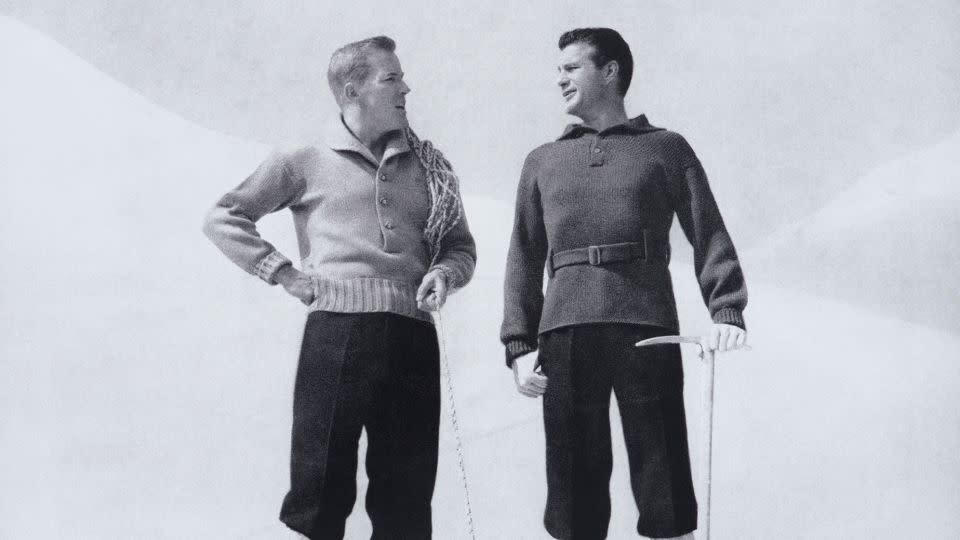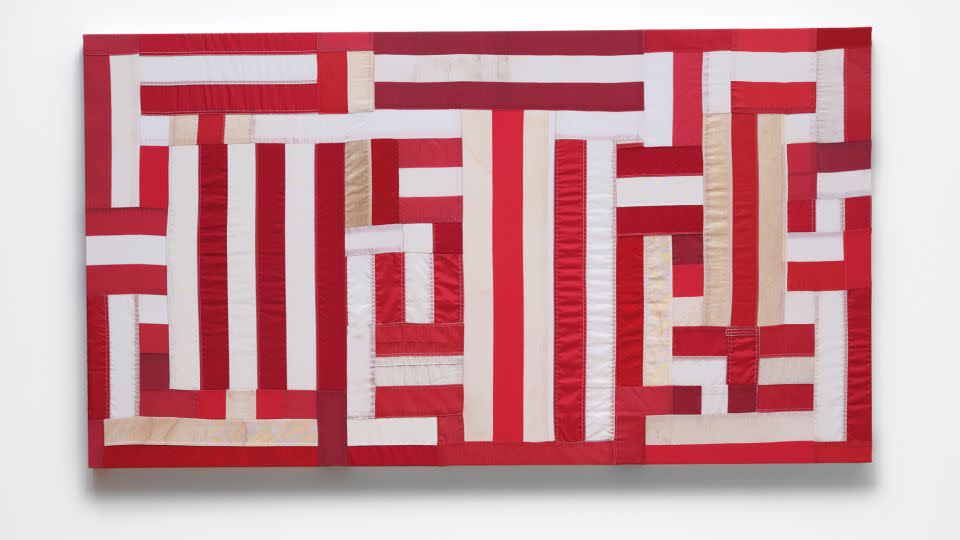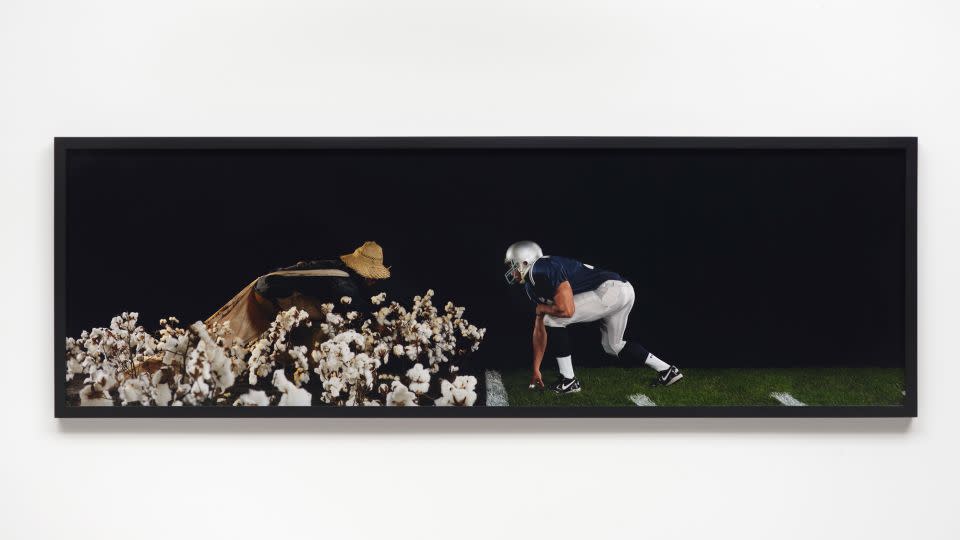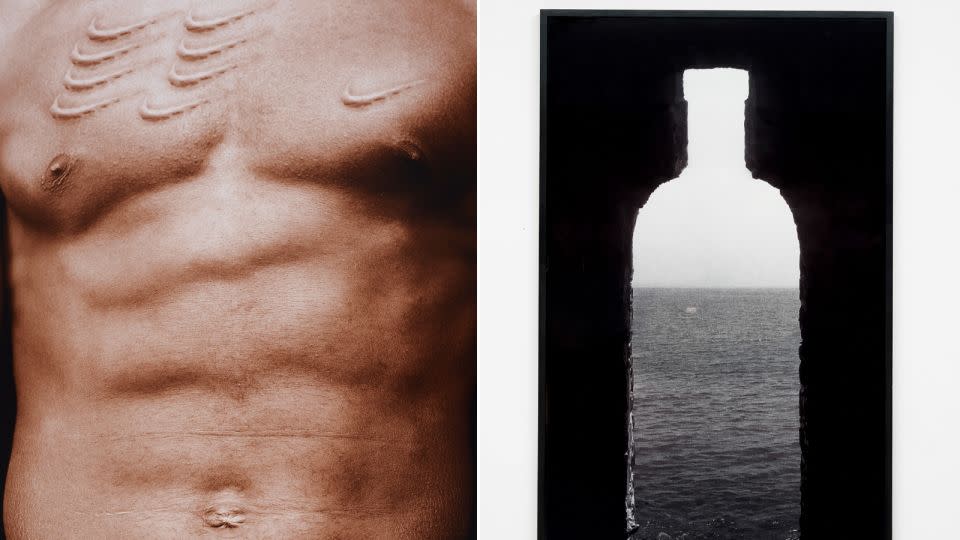An artist reckons with the dangerous power of advertising and iconography
- Oops!Something went wrong.Please try again later.
In Seattle’s Henry Art Gallery, an open, oval room is covered wall-to-wall in women, the visuals spanning a full century from 1915 to 2015. The artist Hank Willis Thomas is pointing to one of the images: of two well-dressed, neatly coiffed men standing atop a cliff.
Below them, a woman is hanging from the peak with a rope.

“Anyone want to guess what this is an ad for?” he asks a group previewing his latest show, “LOVERULES,” on the afternoon of its opening day. “Sweaters?” someone posits. Somehow, they’re correct.
The piece is from Thomas’ largest body of work, “Unbranded: A Century of White Women.” The 2015 series — one of many resurfaced for the “LOVERULES” exhibit — features 101 print adverts (one ad per year), from which Thomas has removed the relevant logos and copy, inviting the viewer to reckon with historical records of femininity and its commodification. The aforementioned image — for Drummond Sweaters — was initially printed in a 1959 issue of “Esquire” magazine. A chorus of scoffs echo throughout the gallery room as Thomas reads its original text: “Men are better than women! Indoors, women are useful — even pleasant. On a mountain they are something of a drag.”
“LOVERULES” threads together Thomas’ most significant practices and themes, particularly the impact of corporate branding, the construction of gender and race, and the evolution of power struggles across movements for liberation. “What does it mean to look at an object that was made to have a three to six month shelf life 40 years later?” Thomas asked, speaking about the show with CNN.
For those in the gallery room, it means discomfort or even disgust when considering an image of a woman with mascara running down her eyes and what looks like a black eye, for example, or another stripped of her clothing surrounded by a group of men. (The former came from a 1963 ad for Tareyton cigarettes, appearing to make light of domestic abuse in its call for “aggressive loyalty” from customers; the latter, in its troubling depiction of what a viewer could all too easily interpret as men preparing to sexually assault a woman, is for pants.)

Throughout the “Unbranded” series, the viewer is confronted with the values embedded in the ethos of advertising — namely, capitalism and the ways in which those who fuel it will tokenize groups and ideas for profit. “What is expected of us is very much informed by advertising, which typically has a specific agenda,” Thomas told CNN. (In other words, buying into the inferiority of women helped sell those sweaters or cigarettes.)
Over the last 20 plus years, Thomas has made a name for himself responding to culturally ingrained narratives of race, gender, class and their intersections in the United States through various mediums — from photo to fabric. Whether he’s mirroring a three-point stanced football player with an enslaved person picking cotton in “The Cotton Bowl,” or mimicking a maze made out of prison uniforms and American flag fabric in “Justice,” Thomas’ work successfully identifies patterns of oppression and asks us to consider how we participate in these systems.

In the complementary series, “Unbranded: Reflections in Black by Corporate America,” Thomas explores ways in which brands invest in or give attention to certain (and often marginalized) communities when it becomes financially convenient — in this case, the corporate appropriation of Black culture. “Somewhere around the late ’60s, I believe as a result of heightened visibility through the Civil Rights movement, corporations started to pay attention,” Thomas explained of the series that assesses ads from 1968 to 2008 (and was intentionally capped when Barack Obama was elected). Before then, he continued, “people of color weren’t seen as a worthwhile demographic to market to, or to represent.”
Both “Unbranded” series assess advertisements as a channel for understanding the place (and power) of racism and sexism throughout American history. Thomas’ visual reflections of popular culture’s past demand an analysis of how corporations commodify belief systems for their own gain — and, in many cases, walk back or even denounce those same beliefs should their profit stumble. (Any focus on queer life ends after a Pride campaign, say, or the celebration of Black stories stops after February sales — in other words, investment in the bottom line will always supersede investment in people or movements.)
To Thomas, these tactics have become even more deceptive as ads have evolved beyond still frames. “With influencers and product placement, (this messaging) is a lot more subtle, more insidious,” he argued. “We’re consuming advertising information without even necessarily knowing it.”

Even in instances when many of us are well aware of the manipulative tactics employed by brands, that doesn’t always stop us from buying in. In his series “B®anded,” part of which is also included in “LOVERULES,” Thomas merges brand logos with altered photos or backdrops to examine how we are beholden to corporations: an Amex that reads “The Afro-American Express,” its central photo of enslaved people crowded on a ship. Close by is an image of a chest covered in scars in the shape of Nike’s logo, speaking to, as Thomas shared, “how slaves were branded as a kind of ownership, and (how) today we brand ourselves.”
Also featured are two of his works reconfiguring the classic Absolut bottle silhouette, one of which resembles the Door of No Return, the symbolic gateway found in Sénegal’s Gorée Island, known as the largest warehouse of enslaved Africans before they were forced onto ships abroad.
Reimagined as artworks, these advertisements are what Thomas deems “messages to the future” and epitomize the more platformed desires and tropes of their time. It begs the question, what of today’s visual messages that we have accepted as normal should, in 40 years time, be interrogated and chastised?
For more CNN news and newsletters create an account at CNN.com

